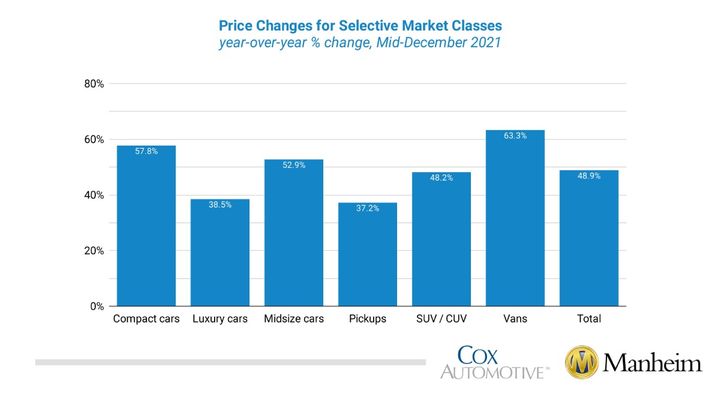
Price Changes for Select Vehicle Classes, Mid-December 2021
Graphic: Cox Automotive
Wholesale used vehicle prices (on a mix-, mileage-, and seasonally adjusted basis) increased 3.1% in the first 15 days of December compared to the month of November, according to a Dec. 17 Cox Automotive news release.
This brought the Manheim Used Vehicle Value Index to 239.8, a 48.9% increase from December 2020. As was the case in October and November, much of the monthly increase was a result of the seasonal adjustment. The non-adjusted price increase through mid-December was 0.7%.
Manheim Market Report (MMR) declined at an accelerating pace over the first two full weeks of December. The Three-Year-Old MMR Index, which represents the largest model year cohort at auction, experienced a 0.6% cumulative decline over the last two weeks. Over the first 15 days of December, MMR Retention, which is the average difference in price relative to current MMR, averaged 99%, which indicates that market prices are now trending below valuation models. The average daily sales conversion rate of 58.6% in the first half of December declined relative to November’s average of 58.9% but remains elevated for this time of year. The latest trends in the key indicators suggest wholesale used vehicle values will likely see further small declines in the second half of the month.
On a year-over-year basis, all major market segments saw seasonally adjusted price gains through the first 15 days of December. Pickups had the smallest year-over-year gains, vans had the largest at 63.3%, and both non-luxury car segments outpaced the overall industry in seasonally adjusted price growth. Compared to November, SUVs and vans had the smallest growth in the first half of December, while compact cars had the largest gain.
Used supply normalizes: Using a rolling seven-day estimate of used retail days’ supply based on vAuto data, we see that used retail supply is now at normal levels at 49 days. Wholesale supply has also improved, marginally below the normal level of 22, at 23 through mid-December.
Rental risk pricing declines month over month: The average price for rental risk units sold at auction in the first 15 days of December was up 28.1% year-over-year. Rental risk prices were down 4.8% compared to November. Average mileage for rental risk units in the first half of December (at 73,495 miles) was up 41% compared to a year ago and down 2.8% month over month.
Auto loan performance continues to deteriorate: Auto loan performance deteriorated again in November. With government support fading and loan accommodations falling, credit performance has started to normalize from historically low delinquencies and defaults during the pandemic. Delinquencies of more than 60 days increased in November for the sixth month in a row and were up 5.2% year over year. In November, 1.36% of auto loans were severely delinquent, which was an increase from 1.33% in October and the highest severe delinquency rate in nine months.
Compared to a year ago, the severe delinquency rate was 6 basis points higher. In November, 5.17% of subprime loans were severely delinquent, which was an increase from 5.05% in October and the highest severe delinquency rate in 10 months. Compared to a year ago, the subprime severe delinquency rate was 46 basis points higher. Loan defaults increased 12.8% in November from October and were up 6.2% year over year. Auto credit access expanded in November. The Dealertrack Auto Credit Availability Index measured auto credit as looser in November compared to February 2020 before the pandemic began for all types of loans and for all types of lenders.
Originally posted on Vehicle Remarketing
